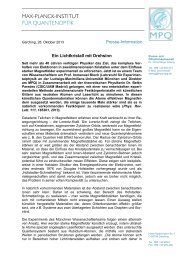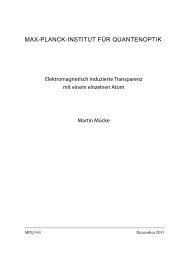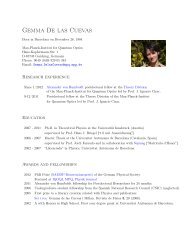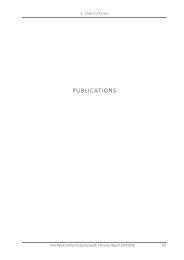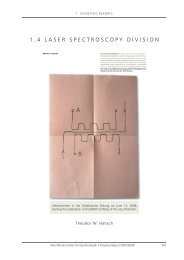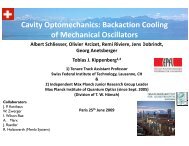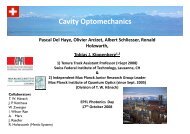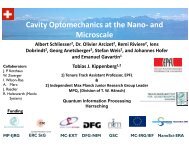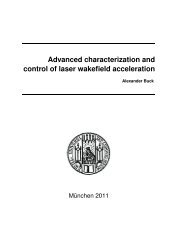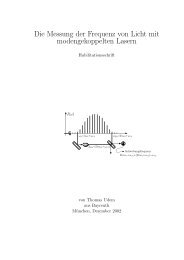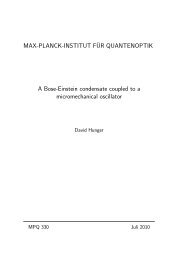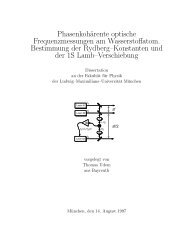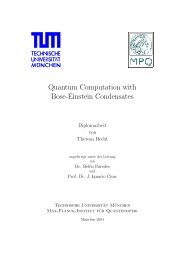Attosecond Control and Measurement: Lightwave Electronics
Attosecond Control and Measurement: Lightwave Electronics
Attosecond Control and Measurement: Lightwave Electronics
You also want an ePaper? Increase the reach of your titles
YUMPU automatically turns print PDFs into web optimized ePapers that Google loves.
ARTICLES<br />
1 . 3 AT T O S E C O N D A N D H I G H - F I E L D P H Y S I C S D I V I S I O N<br />
Coherent superposition of laser-driven<br />
soft-X-ray harmonics from successive<br />
sources<br />
J. SERES 1,2 , V. S. YAKOVLEV 3 , E. SERES 1,2 , CH. STRELI 4 , P. WOBRAUSCHEK 4 , CH. SPIELMANN 2<br />
AND F. KRAUSZ 3,5 *<br />
1 Institut für Photonik, Technische Universität Wien, A-1040 Wien, Austria<br />
2 Physikalisches Institut EP1, Universität Würzburg, D-97074 Würzburg, Germany<br />
3 Department für Physik, Ludwig-Maximilians-Universität München, D-85748 Garching, Germany<br />
4 Atominstitut der Österreichischen Universtitäten, Technische Universität Wien, A-1020 Wien, Austria<br />
5 Max-Planck-Institut für Quantenoptik, D-85748 Garching, Germany<br />
*e-mail: krausz@lmu.de<br />
Published online: 11 November 2007; doi:10.1038/nphys775<br />
High-order harmonic generation from atoms ionized by femtosecond laser pulses has been a promising approach for the development<br />
of coherent short-wavelength sources. However, the realization of a powerful harmonic X-ray source has been hampered by a phase<br />
velocity mismatch between the driving wave <strong>and</strong> its harmonics, limiting their coherent build-up to a short propagation length <strong>and</strong><br />
thereby compromising the efficiency of a single source. Here, we report coherent superposition of laser-driven soft-X-ray (SXR)<br />
harmonics, at wavelengths of 2–5 nm, generated in two successive sources by one <strong>and</strong> the same laser pulse. Observation of constructive<br />
<strong>and</strong> destructive interference suggests the feasibility of quasi-phase-matched SXR harmonic generation by a focused laser beam in a<br />
gas medium of modulated density. Our proof-of-concept study opens the prospect of enhancing the photon flux of SXR harmonic<br />
sources to levels enabling researchers to tackle a range of applications in physical as well as life sciences.<br />
The quest for powerful laboratory sources of coherent soft-X-ray<br />
(SXR) light has been ongoing since the discovery of the laser.<br />
So far, high-order harmonic generation from atoms ionized by<br />
ultrashort laser pulses 1,2 constitutes the only technique providing<br />
coherent short-wavelength radiation at any photon energy up<br />
to the kiloelectronvolt regime 3–11 . Laser-driven high-harmonic<br />
sources (henceforth briefly referred to as harmonic sources) up<br />
to photon energies of 100 eV are now in widespread use 12 <strong>and</strong><br />
have played a key role in pushing the frontiers of nonlinear<br />
optics into the extreme-ultraviolet region 13–17 <strong>and</strong> ultrafast science<br />
into the attosecond domain 18–23 . Above 100 eV, rapidly decreasing<br />
efficiency prevented harmonic sources from becoming useful for<br />
applications. The low harmonic conversion efficiency implies that<br />
most of the incident laser photons are transmitted through the<br />
harmonic source, offering the possibility of being reused for<br />
creating harmonics in successive sources <strong>and</strong>—by exploiting their<br />
coherence—adding them to increase the overall harmonic flux.<br />
Here, we demonstrate the feasibility of this approach.<br />
Efficient generation of high-order harmonics of intense laser<br />
light relies on a large number of ionizing atoms emitting<br />
high-frequency radiation with proper phase that allows coherent<br />
build-up of light on propagation through the generation medium.<br />
Free electrons, unavoidable concomitants of the generation<br />
process, tend to severely limit the propagation length over which<br />
phase-matching can be achieved (henceforth briefly referred to as<br />
the coherence length). Femtosecond laser pulses have permitted<br />
the generation of harmonics in the extreme-ultraviolet regime<br />
(10–100 eV) at sufficiently low levels of ionization, so that the<br />
coherence length could be extended beyond the absorption<br />
length 4,5 , leading to the production of microjoule-energy coherent<br />
extreme-ultraviolet pulses 6,7 .<br />
Generation of SXR harmonics (>100 eV) is favoured by<br />
lowered absorption but suffers from increased free-electron density<br />
implied by the higher laser intensities required. Hence, the<br />
efficiency of SXR harmonic sources is limited by dephasing of<br />
the atomic dipole oscillators driven at different positions in the<br />
generation medium 24 . The SXR harmonic yield has recently been<br />
improved by implementing quasi-phase-matching (QPM) in a<br />
gas-filled hollow-core fibre with a modulated inner diameter 8 or<br />
counter-propagating laser pulses 25,26 . At higher photon energies,<br />
subcycle modification of few-cycle driving fields has been identified<br />
as being beneficial for enhancing phase-matching 27 (referred to<br />
as non-adiabatic self-phase-matching), which allowed extension<br />
of harmonic generation beyond the kiloelectronvolt frontier 10,11 .<br />
Unfortunately the fluxes demonstrated so far are still insufficient<br />
for most applications.<br />
Here, we provide the first experimental evidence of the<br />
feasibility of enhancing the efficiency of SXR harmonic generation<br />
by coherent superposition of harmonics generated in successive<br />
sources traversed by the same pump laser beam (Fig. 1). SXR<br />
harmonic emission from a single source is maximized by using<br />
few-cycle driver pulses, which maximize both the single-atom<br />
emission intensity <strong>and</strong> the coherence length for SXR harmonics 24 ,<br />
<strong>and</strong> is limited by dephasing. The phase of the atomic dipole<br />
878 nature physics VOL 3 DECEMBER 2007 www.nature.com/naturephysics<br />
© 2007 Nature Publishing Group<br />
180 Max-Planck-Institut für Quantenoptik • Progress Report 2007/2008



